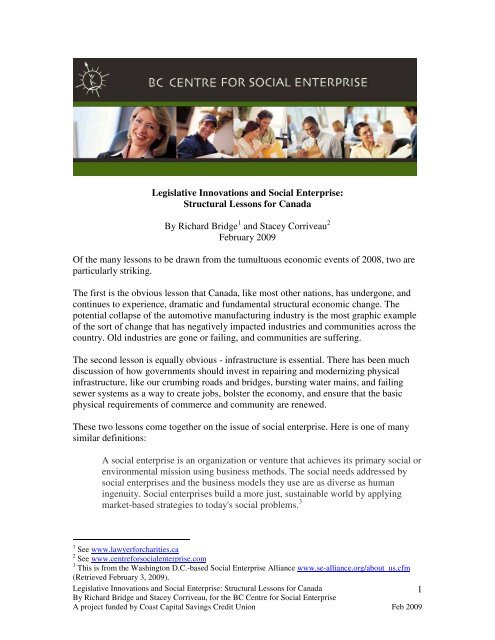1 Legislative Innovations and Social Enterprise: Structural Lessons ...
1 Legislative Innovations and Social Enterprise: Structural Lessons ...
1 Legislative Innovations and Social Enterprise: Structural Lessons ...
You also want an ePaper? Increase the reach of your titles
YUMPU automatically turns print PDFs into web optimized ePapers that Google loves.
<strong>Legislative</strong> <strong>Innovations</strong> <strong>and</strong> <strong>Social</strong> <strong>Enterprise</strong>:<strong>Structural</strong> <strong>Lessons</strong> for CanadaBy Richard Bridge 1 <strong>and</strong> Stacey Corriveau 2February 2009Of the many lessons to be drawn from the tumultuous economic events of 2008, two areparticularly striking.The first is the obvious lesson that Canada, like most other nations, has undergone, <strong>and</strong>continues to experience, dramatic <strong>and</strong> fundamental structural economic change. Thepotential collapse of the automotive manufacturing industry is the most graphic exampleof the sort of change that has negatively impacted industries <strong>and</strong> communities across thecountry. Old industries are gone or failing, <strong>and</strong> communities are suffering.The second lesson is equally obvious - infrastructure is essential. There has been muchdiscussion of how governments should invest in repairing <strong>and</strong> modernizing physicalinfrastructure, like our crumbing roads <strong>and</strong> bridges, bursting water mains, <strong>and</strong> failingsewer systems as a way to create jobs, bolster the economy, <strong>and</strong> ensure that the basicphysical requirements of commerce <strong>and</strong> community are renewed.These two lessons come together on the issue of social enterprise. Here is one of manysimilar definitions:A social enterprise is an organization or venture that achieves its primary social orenvironmental mission using business methods. The social needs addressed bysocial enterprises <strong>and</strong> the business models they use are as diverse as humaningenuity. <strong>Social</strong> enterprises build a more just, sustainable world by applyingmarket-based strategies to today's social problems. 31 See www.lawyerforcharities.ca2 See www.centreforsocialenterprise.com3 This is from the Washington D.C.-based <strong>Social</strong> <strong>Enterprise</strong> Alliance www.se-alliance.org/about_us.cfm(Retrieved February 3, 2009).<strong>Legislative</strong> <strong>Innovations</strong> <strong>and</strong> <strong>Social</strong> <strong>Enterprise</strong>: <strong>Structural</strong> <strong>Lessons</strong> for Canada1By Richard Bridge <strong>and</strong> Stacey Corriveau, for the BC Centre for <strong>Social</strong> <strong>Enterprise</strong>A project funded by Coast Capital Savings Credit Union Feb 2009
The first lesson (fundamental economic change) underscores the urgency of the need toadapt <strong>and</strong> redesign the ways in which our economy <strong>and</strong> communities function, as the oldindustrial model will not be coming back in its old form. <strong>Social</strong> enterprise should be atthe forefront of this redesign.The link to the second lesson is that infrastructure is more than bricks, mortar, <strong>and</strong>pavement. Physical infrastructure is indeed essential, but of equal importance is theorganizational or legal infrastructure – the laws, regulations, <strong>and</strong> public policies thatenable the adaptation, redesign, <strong>and</strong> rebuilding needed by our economy <strong>and</strong> communities.Though not as dramatic as a burst water main, nor nearly as expensive to modernize asphysical infrastructure, the organizational infrastructure needs attention too.This paper argues that governments should modernize the organizational infrastructurethat applies to social enterprise to better enable it to flourish. A relatively modest startwould be new legislation enabling the creation of a legal structure specifically for thepurpose of social enterprise. “<strong>Social</strong> <strong>Enterprise</strong>” is not a legal expression in Canada. There is no national or provincialsocial enterprise act or regulation that defines it or gives it legal form or structure. It isnot addressed in the voluminous federal Income Tax Act as something distinct <strong>and</strong> worthyof unique treatment.Instead, social enterprises in Canada take a variety of different organizational forms.They can be:• A sole proprietorship or partnership registered under provincial legislation.• A corporation incorporated under either provincial or federal legislation.• A co-operative incorporated provincially, or, if it is carrying on business in morethan one province, incorporated federally.• A non-profit organization incorporated under provincial “society” or equivalentlegislation, or under Part II of the Canada Corporations Act.• A registered charity engaging in “related business.” 4• A non-profit or charity that owns a for-profit business (which can take differentorganizational forms).<strong>Social</strong> enterprises can also be undertaken as programs, projects, joint ventures, or otheragreements between any of the above legal structures or individuals.“Community <strong>Enterprise</strong>” is an alternative name for organizations or ventures of this typethat may better capture their essence as part of the middle ground between the state <strong>and</strong>4 See 2003 CRA policy statement www.cra-arc.gc.ca/tx/chrts/plcy/cps/cps-019-eng.html (RetrievedFebruary 3, 2009).<strong>Legislative</strong> <strong>Innovations</strong> <strong>and</strong> <strong>Social</strong> <strong>Enterprise</strong>: <strong>Structural</strong> <strong>Lessons</strong> for Canada2By Richard Bridge <strong>and</strong> Stacey Corriveau, for the BC Centre for <strong>Social</strong> <strong>Enterprise</strong>A project funded by Coast Capital Savings Credit Union Feb 2009
the market. The two names are used interchangeably here. Unfortunately, “communityenterprise” is also without legal meaning in Canada.Operators of social or community enterprises have been creatively working with theavailable legal structures. But in Canada, there has been virtually no correspondinglegislative or regulatory innovation. 5 The organizational infrastructure has not kept pacewith the growing sophistication of community enterprise.Of the existing legal structures, only the co-operative expressly embraces notions similarto social enterprise. One of the internationally recognized principles shared by all co-opsis “concern for community.” The International Co-operative Alliance states, as one of itsseven key principles, that “while focusing on member needs, co-operatives work for thesustainable development of their communities through policies accepted by theirmembers.” 6 This principle applies to all co-ops, whether they are for-profit or non-profit.The other legal structures do not fit as well with the notion of social or communityenterprise. Charities must be established for exclusively charitable purposes, <strong>and</strong> theirability to utilize market-based strategies is limited. Profit cannot flow from charities tomembers or directors. Such payments are strictly prohibited. Similarly, non-profitorganizations cannot be incorporated for the purpose of making profits, nor can they issueshares or pay dividends. Corporations are designed to maximize profits for shareholders,though shareholders may decide to forego some of that profit to enable the corporation toengage in activities that benefit the community.The existing legal infrastructure utilized by Canada’s community enterprises is apatchwork. The quality of the relevant legislative <strong>and</strong> regulatory systems varies fromprovince to province. Most are badly dated, incomplete, <strong>and</strong> inadequate.CANADA CORPORATIONS ACTThe best illustration of the dated nature of the legal infrastructure in this area is theCanada Corporations Act, which governs thous<strong>and</strong>s of federally incorporated non-profitorganizations <strong>and</strong> charities. It has changed little since 1917, <strong>and</strong> is sadly inadequate. Afull critique is not possible here, but briefly, it lacks detail <strong>and</strong> clarity on a range ofimportant issues relating to governance, accountability, <strong>and</strong> administration.5 An exception is the adoption over the last couple of decades in the federal <strong>and</strong> most provincial cooperativelegislation of the capacity for co-ops to issue investment shares. Regarding charities, the CanadaRevenue Agency has produced helpful policy statements regarding “Community Economic DevelopmentPrograms” http://www.cra-arc.gc.ca/E/pub/tg/rc4143/rc4143-e.html (Retrieved February 3, 2009) <strong>and</strong>“Related Business” http://www.cra-arc.gc.ca/tx/chrts/plcy/cps/cps-019-eng.html (Retrieved February 3,2009), but these are interpretations of existing (sparse) legislation <strong>and</strong> infrequent <strong>and</strong> conflicting case law.6 www.canadabusiness.ca/servlet/ContentServer?cid=1081945277001&pagename=CBSC_SK%2Fdisplay&lang=en&c=GuideFactSheet (Retrieved February 3, 2009).<strong>Legislative</strong> <strong>Innovations</strong> <strong>and</strong> <strong>Social</strong> <strong>Enterprise</strong>: <strong>Structural</strong> <strong>Lessons</strong> for Canada3By Richard Bridge <strong>and</strong> Stacey Corriveau, for the BC Centre for <strong>Social</strong> <strong>Enterprise</strong>A project funded by Coast Capital Savings Credit Union Feb 2009
Its failings are recognized by Corporations Canada <strong>and</strong> others in the federal government,<strong>and</strong> substantial work has been done in an attempt to modernize it. In 2005, Bill C-21 wasintroduced by the then Liberal minority government, but it was not passed. In June of2008, the Conservative minority introduced Bill C-62, which was very similar to Bill C-21, <strong>and</strong> shared its fate – it died on the order paper when the 2008 election was called. OnDecember 3, 2008, this proposed legislation reappeared as Bill C-4. 7 Parliament wasprorogued on the following day.Prorogation means that all government bills not yet passed “cease to exist” <strong>and</strong> must bereintroduced as new bills, or they may be reinstated, with consent of the House ofCommons. 8 While the fate of this important legislative overhaul is in doubt, it doesappear to have at least some level of bi-partisan support as a sensible step forward.But Bill C-4 <strong>and</strong> its earlier iterations do not address the concept of social or communityenterprise. If passed, this modernization will improve the governance, accountability, <strong>and</strong>administration of existing <strong>and</strong> future non-profits <strong>and</strong> charities that incorporate federally,but there is nothing in those improvements that is specifically intended to enablecommunity enterprise.ONTARIO’S NON-PROFIT AND CHARITY REGIMEIn Ontario, the legislation that governs provincially incorporated non-profit organizations<strong>and</strong> charities is also dated, incomplete, <strong>and</strong> in need of an overhaul. Unlike otherprovinces, which leave the administration of charities to the Charities Directorate atCanada Revenue Agency, Ontario takes an active role in the administration of charities.Ontario’s Charitable Gifts Act prohibits charities from owning more than a 10% interestin any business. 9 This is an impediment to the practice used in other provinces <strong>and</strong> withfederally incorporated charities, of charities creating <strong>and</strong> owning for-profit businessesthat engage in commercial activities which the charities themselves cannot undertake.The Ontario government is working to modernize this legal infrastructure <strong>and</strong> the recentUK <strong>and</strong> US innovations will probably inform that work.NOVA SCOTIA SOCIETIESThe Nova Scotia Societies Act states that a society cannot be incorporated “for thepurpose of carrying on any trade, industry or business”. This restriction is applied broadlyto include organizations with charitable or other non-profit purposes that intend to chargefees for services (educational workshops for example) in order to generate revenue to paystaff <strong>and</strong> other costs on a break-even or non-profit basis. Incorporation will not bepermitted if fees will be charged for core services unless the work is carried out by 90%7 http://www2.parl.gc.ca/HousePublications/Publication.aspx?DocId=3625950&Language=e&Mode=1(Retrieved February 3, 2009).8 www.parl.gc.ca/compendium/web-content/c_d_prorogationparliament-e.htm9 See Carter & Man p. 24 for a more detailed discussion. It is available at:www.carters.ca/pub/article/charity/2008/tsc1024.pdf<strong>Legislative</strong> <strong>Innovations</strong> <strong>and</strong> <strong>Social</strong> <strong>Enterprise</strong>: <strong>Structural</strong> <strong>Lessons</strong> for Canada4By Richard Bridge <strong>and</strong> Stacey Corriveau, for the BC Centre for <strong>Social</strong> <strong>Enterprise</strong>A project funded by Coast Capital Savings Credit Union Feb 2009
volunteers. In contrast, other jurisdictions permit societies to engage in “business” solong as it is not for the profit or pecuniary gain of members. 10This approach is much narrower than in other provinces <strong>and</strong> under the CanadaCorporations Act, by which fees can be charged for core services by societies (or“corporations without share capital” as they are called in some of the legislation) so longas the purpose is not profit or gain for directors or members of the organization. Another gap for social enterprises is the fact that in some provinces with older cooperativelegislation <strong>and</strong> regulatory regimes, it is not possible for co-ops to issueinvestment shares. 11 For co-operatives incorporated under federal legislation or inprovinces with more modern co-operative legal infrastructure, this is an option that isattractive from a social enterprise perspective. The co-op model is successful for manysocial enterprises, but it does not meet the needs of all enterprises <strong>and</strong> situations. The relationship between charity <strong>and</strong> social enterprise is not very clear. That relationshipis beyond the scope of this paper. Interested readers will find a paper on this topic byCanadian lawyers Terrance Carter <strong>and</strong> Theresa Man 12 very informative.Very briefly, charity law is poorly developed in Canada. Unlike the UK, Canada has nonational Charities Act that addresses the key principles <strong>and</strong> practices. 13 The provinceshave constitutional jurisdiction over charities, but administration has fallen primarily tothe federal government through its taxing powers. The favourable tax treatment thatcharities receive has resulted in the creation within the Canada Revenue Agency of theCharities Directorate to adminiser the field nationally.Charity law is found in disjointed sections of the federal Income Tax Act, some provinciallegislation, <strong>and</strong> a body of case law that goes back centuries but rarely exp<strong>and</strong>s. TheCharities Directorate attempts to hold this poorly developed law together withadministrative policies that fill in gaps <strong>and</strong> try to bring sense to the confusion.When it comes to charity <strong>and</strong> social enterprise, the Income Tax Act <strong>and</strong> the limited caselaw leave sizable gaps <strong>and</strong> considerable confusion. For example, charities may engage in10 See for example Section 2 of the BC Society Act, or section 154 of the Canada Corporations Act.11 For example, see the New Brunswick Co-operative Associations Acthttp://www.gnb.ca/0062/acts/acts/c-22-1.htm (Retrieved February 3, 2009).12 Canadian Registered Charities: Business Activities <strong>and</strong> <strong>Social</strong> <strong>Enterprise</strong> – Thinking Outside the Box.See http://www.carters.ca/pub/article/charity/2008/tsc1024.pdf (Retrieved February 3, 2009).13 The Charities Act 2006 is a comprehensive modernization of charity law in Engl<strong>and</strong> <strong>and</strong> Wales. Itincludes a new definition of ‘charity ’ that replaces the four heads of charity adopted in the Victorian erabased on a statute from the Elizabethan era. It also includes modern provisions for the governance <strong>and</strong>regulation of charities. See http://www.opsi.gov.uk/acts/acts2006/ukpga_20060050_en_1 (RetrievedFebruary 3, 2009).<strong>Legislative</strong> <strong>Innovations</strong> <strong>and</strong> <strong>Social</strong> <strong>Enterprise</strong>: <strong>Structural</strong> <strong>Lessons</strong> for Canada5By Richard Bridge <strong>and</strong> Stacey Corriveau, for the BC Centre for <strong>Social</strong> <strong>Enterprise</strong>A project funded by Coast Capital Savings Credit Union Feb 2009
“related business,” but this concept is not fully defined in the Act, <strong>and</strong> the case lawaddressing it is inconsistent. Two Charities Directorate policy statements attempt to patchthings up. One deals with Community Economic Development, 14 <strong>and</strong> the other with“related business” undertaken by charities. 15 These documents are helpful, but notwithout shortcomings. They are also administrative interpretations, not law, <strong>and</strong> they maytherefore not st<strong>and</strong> up to future judicial scrutiny.Here are the key lessons to be drawn from this guidance:• <strong>Social</strong> or community enterprise is not defined. The administrative guidance refersto “social businesses” but defines them narrowly as sheltered workshops forpersons with disabilities. 16• Charities may charge fees in relation to their charitable activities <strong>and</strong> programs.• Any surplus must be devoted to the purposes of the charity.• Private profit or benefit from charitable resources by directors or trustees isstrictly prohibited. Champions of social enterprises need to make a difficultdecision: either act as a paid employee <strong>and</strong> relinquish governance over the veryventure that they founded, or serve on the Board in an unpaid position.• The short definition of “business” is “commercial activity – deriving revenuesfrom providing goods or services – undertaken with the intention to earn profit”.• Charities cannot engage directly in “unrelated business”. A business activity willbe considered “related” if : a) it is run substantially by volunteers or b) it is linkedto a charity's purpose <strong>and</strong> subordinate to that purpose.• It is not a sufficient link that all of the profits generated by the business activityare devoted to the purposes of the charity.• It is not a sufficient link that the social enterprise serves or employs theconstituents named in the organization’s charitable objects.• Private foundations (one of the three categories of charities, along with charitableorganizations <strong>and</strong> public foundations) may not engage in any business activities,<strong>and</strong> neither private nor public foundations may acquire more than half of thevoting shares of a taxable corporation, unless the shares are donated to thefoundation.• Soliciting donations or selling donated goods are not considered to be businessactivity (<strong>and</strong> are therefore clearly allowable, within limits).• Charities may establish separate corporate entities to perform activities that theycannot perform directly themselves. If that activity is business, it must be housedwithin a taxable corporation. If the activity is not considered by the CharitiesDirectorate to be “business” <strong>and</strong> is not charitable, it can be housed in a non-profitorganization. With some exceptions, charities can retain control over such ataxable corporation or non-profit organization.14 www.cra-arc.gc.ca/E/pub/tg/rc4143/rc4143-e.html (Retrieved February 3, 2009).15 www.cra-arc.gc.ca/tx/chrts/plcy/cps/cps-019-eng.html (Retrieved February 3, 2009).16 www.cra-arc.gc.ca/E/pub/tg/rc4143/rc4143-e.html (Retrieved February 3, 2009).<strong>Legislative</strong> <strong>Innovations</strong> <strong>and</strong> <strong>Social</strong> <strong>Enterprise</strong>: <strong>Structural</strong> <strong>Lessons</strong> for Canada6By Richard Bridge <strong>and</strong> Stacey Corriveau, for the BC Centre for <strong>Social</strong> <strong>Enterprise</strong>A project funded by Coast Capital Savings Credit Union Feb 2009
In summary, a registered charity considering engaging in community enterprise needs tobe very careful not to run afoul the laws <strong>and</strong> policies administered by the CharitiesDirectorate. Transgressions can result in loss of charitable status. It may be necessary forthe charity to create a separate corporate entity to house that activity. Extra care is neededin Ontario, as noted above, <strong>and</strong> if the charity in question is a private or public foundation. In 2005, a new legislative <strong>and</strong> regulatory framework came into force in the UnitedKingdom, specifically supporting a new legal structure for social enterprise. TheCompanies (Audit, Investigations <strong>and</strong> Community <strong>Enterprise</strong>) Act 2004 <strong>and</strong> theCommunity Interest Company Regulations 2005 (the “New Act”) enabled the creation of anew type of company called Community Interest Companies, or “CICs.”Community Interest Companies have these essential attributes:1) They are established to trade (goods or services) for the community good. Toqualify for CIC status, the company must submit to the CIC Regulator a“community interest statement” that includes:a. certification that it has been formed to serve the community rather than tomake private profits;b. a declaration that it will not engage in political activity;c. a description of its activities <strong>and</strong> how they will benefit the community; <strong>and</strong>d. a description of how surpluses will be used.Subsequent annual reports are required to confirm that the CIC continues to meetthe community interest requirement. These reports are available for public review,ensuring a high level of transparency.2) They may issue shares in order to raise capital. But unlike a traditional businesscorporation, the dividends that can be paid by CICs on these shares are controlledby a cap on returns set by the Regulator.3) They are subject to an “asset lock”, which means that the assets <strong>and</strong> profits mustbe permanently retained by the CICs for community benefit, or transferred toanother CIC subject to an asset lock, or to a charity.4) They are subject to fewer regulations than charities, <strong>and</strong> may be established forpurposes that do not meet the legal test of charity. But CICs do not enjoy the samefavourable tax treatment that charities receive. They are taxed in the same manneras other businesses.By February 24, 2009, 2,481 CICs had been established in the UK. They are listed on theCIC Regulator’s website 17 <strong>and</strong> they are pursuing a wide range of works, such as17 http://www.cicregulator.gov.uk/coSearch/companyList.shtml (Retrieved February 24, 2009).<strong>Legislative</strong> <strong>Innovations</strong> <strong>and</strong> <strong>Social</strong> <strong>Enterprise</strong>: <strong>Structural</strong> <strong>Lessons</strong> for Canada7By Richard Bridge <strong>and</strong> Stacey Corriveau, for the BC Centre for <strong>Social</strong> <strong>Enterprise</strong>A project funded by Coast Capital Savings Credit Union Feb 2009
affordable housing, the arts, education <strong>and</strong> training, pre-schools, home support services,recycling, <strong>and</strong> the promotion of international trade.This innovation has several important strengths.Legitimacy. Creating a separate legal form provides additional legitimacy for socialenterprise. The New Act represents confirmation by Parliament that activities of this typeare important <strong>and</strong> should be encouraged.Profile. Similarly, the New Act <strong>and</strong> related initiatives raise the profile of communityenterprise, <strong>and</strong> expose more people to the basic concepts, <strong>and</strong> may attract moreparticipants.Investments. Perhaps the most dramatic strength of this innovation is the explicitcombination of private investment capital with activities that benefit community. InCanada <strong>and</strong> elsewhere, limited access to capital is arguably the greatest obstacle to socialenterprise projects, such as affordable housing, rural or urban community economicdevelopment, <strong>and</strong> environmental initiatives. Many projects are capable of becomingviable once established, but too often do not succeed due to lack of access to patientcapital. For projects that fall outside the realm of charity, donations may be difficult toattract. With projects that are charitable, donations are often unpredictable <strong>and</strong>unsustainable.CICs are able to do what Canadian charities <strong>and</strong> non-profit organizations cannot directlyaccomplish themselves – raise equity capital. That is, raise funds in exchange for shares,the way that traditional business corporations <strong>and</strong> some co-ops do. This enables <strong>and</strong>encourages the investment of private wealth in community projects – a combination withenormous potential.Cap on Returns. This creative feature is a potentially useful administrative tool to ensurea reasonable balance between the interests of investors <strong>and</strong> the community interest whenit comes to dividend payments.An Option. The UK innovation creates an option for community enterprise. It does notrender other structures or approaches unlawful or invalid, or force future projects to adoptthe new form.Room to Evolve. Another strength is the “community interest” test created by the NewAct. It features a lower threshold than the test of charity, <strong>and</strong> it is not codified in detail.Instead, it is fluid <strong>and</strong> will evolve over time as the community enterprise sector develops.The Asset Lock. This simple feature helps to ensure that assets intended for communitybenefit remain in that realm.<strong>Legislative</strong> <strong>Innovations</strong> <strong>and</strong> <strong>Social</strong> <strong>Enterprise</strong>: <strong>Structural</strong> <strong>Lessons</strong> for CanadaBy Richard Bridge <strong>and</strong> Stacey Corriveau, for the BC Centre for <strong>Social</strong> <strong>Enterprise</strong>8A project funded by Coast Capital Savings Credit Union Feb 2009
There is a substantial advantage for Canada in having the UK innovation well underway.If the federal or provincial governments decide to adopt something similar, they canreplicate aspects of the model <strong>and</strong> make refinements based on lessons learned throughseveral years of experience in the UK. One area that may be refined is the amount of thecap on investments returns. The current cap of 5% has been criticized as too low forinvestments with substantial risk. Another area where change may be needed is taxtreatment. Income tax exemption may be appropriate, as may tax credits to encourageinvestment. Something similar to Labour-Sponsored Venture Capital Tax Credits orNova Scotia’s Community Economic Development Investment Funds may be prudent,<strong>and</strong> are being explored in some jurisdictions. Changes similar to those in the UK are now occurring in the United States. On April 30,2008, Vermont passed legislation that enables the creation of new legal entities calledLow-Profit Limited Liability Companies, or L3Cs. At time of writing, similar legislationis before the North Carolina State Legislature. The Vermont legislation allows L3Cscreated in that state to operate across the country. The primary goal of these legal changesis to introduce market solutions to community needs by providing “access [to] the vastpools of market driven wealth to make socially responsible investments in so callednonprofit areas.” 18L3Cs are a variation on American Limited Liability Companies (LLCs), which are a formof business partnership that can issue shares. LLC investors are members rather thanshareholders. LLCs are established by an operating agreement among the members. Withan L3C, the terms of the operating agreement guarantee the public benefit nature of theentity’s work. Like LLCs, L3Cs are not subject to federal income tax themselves, but theincome they pay to members is taxable according to the rates applicable to each member.Very importantly, L3Cs are able to attract private capital for their works through the saleof shares <strong>and</strong> other securities, various forms of loans, or other commercial financialarrangements.A key feature of the L3C innovation is the ability that they provide to Americancharitable foundations to make Program Related Investments in these new legal entities.This substantial pool of investment capital will enable L3Cs to attract or leverage othercapital (from pension funds, institutional <strong>and</strong> individual investors, banks, insurancecompanies, etc.) to undertake community projects that make sound business sense.The essential strength of the L3C innovation appears to be the capacity to attract capitalby issuing shares, as CICs do. Canada does not possess the same pools of foundationcapital that exist in the US, but the potential to combine foundation capital <strong>and</strong> privatecapital for community projects is very attractive <strong>and</strong> potentially powerful.18 Lang, R.M.Jr. (n.d.) Overview. Americans for Community Development. Retrieved February 3, 2009from http://americansforcommunitydevelopment.org/supportingdownloads/ACDOverview.pdf .<strong>Legislative</strong> <strong>Innovations</strong> <strong>and</strong> <strong>Social</strong> <strong>Enterprise</strong>: <strong>Structural</strong> <strong>Lessons</strong> for CanadaBy Richard Bridge <strong>and</strong> Stacey Corriveau, for the BC Centre for <strong>Social</strong> <strong>Enterprise</strong>9A project funded by Coast Capital Savings Credit Union Feb 2009
In Canada, charitable foundations may only make Program Related Investments in otherregistered charities or to “qualified donees” 19 The Income Tax Act would need to beamended to broaden this investment scope, <strong>and</strong> provincial trust law would need to beamended to exp<strong>and</strong> the investment powers of trustees to go beyond the “prudent investortest”. Some concerns or doubts have been raised as to whether Canada should follow the UK orUS leads <strong>and</strong> create a new structure for social or community enterprise. Here are theconcerns, with some responses.1. The current choices of organizational forms for social enterprises in Canadaare sufficient <strong>and</strong> there is no need to add another structural option.<strong>Social</strong> enterprises will continue to emerge <strong>and</strong> grow with or without the adoptionof the changes proposed here. The expectation is that a Community <strong>Enterprise</strong> Actwould create another choice of form, increased profile <strong>and</strong> recognition for thesector, <strong>and</strong> a focus for additional legislative <strong>and</strong> regulatory innovations. Theaddition of a new option in no way compromises existing structures. It merelyoffers another choice.2. There are other higher priorities in terms of legislation to support socialenterprise. Favourable tax treatment <strong>and</strong> access to other sources of capitalare more important.A Community <strong>Enterprise</strong> Act creates an opportunity for the Government ofCanada to do more for social or community enterprise than just enable a newstructure. Such an Act could reference favourable tax treatment or other publicpolicies designed to help these entities to succeed. Additional innovations couldtake the form of additions or revisions to this Act in the future.3. The creation of a new structure for social enterprise may discredit orundermine the structures currently in use by social enterprises.This is not the case. The intention is for the proposed Community <strong>Enterprise</strong> Actto provide another choice of structure for social enterprises. The legislation couldprovide a definition of “Community Benefit” <strong>and</strong> a mechanism for entitiesincorporated under other federal or provincial legislation that meet that test to beeligible for favourable tax treatment <strong>and</strong> other incentives which the Governmentof Canada may decide to establish. Existing social enterprises would not becompelled to change their legal structure to comply with this new Act.19 www.cra-arc.gc.ca/tx/chrts/plcy/csp/csp-q01-eng.html (Retrieved February 3, 2009).<strong>Legislative</strong> <strong>Innovations</strong> <strong>and</strong> <strong>Social</strong> <strong>Enterprise</strong>: <strong>Structural</strong> <strong>Lessons</strong> for CanadaBy Richard Bridge <strong>and</strong> Stacey Corriveau, for the BC Centre for <strong>Social</strong> <strong>Enterprise</strong>10A project funded by Coast Capital Savings Credit Union Feb 2009
4. Loans or debt financing is adequate to finance social enterprise by non-profitorganizations.In Canada <strong>and</strong> elsewhere, limited access to capital is a major obstacle tocommunity or social enterprise, such as affordable housing, rural or urbancommunity economic development, <strong>and</strong> environmental initiatives. Some socialenterprises are capable of being self-sufficient once established, but too often donot succeed due to lack of access to capital. These projects often fall outside therealm of charity, so they cannot be supported by charitable donations. For projectsthat can receive charitable donations, this source of funding is often toounpredictable <strong>and</strong> unsustainable to support many worthy community enterprises.In addition, community benefit projects are usually undertaken by non-profitorganizations that lack the legal capacity to raise equity capital – that is, to raisefunds in exchange for shares, the way that traditional business corporations do.Enabling new community enterprises to tap into private capital by issuing sharesis a powerful feature of the proposed new Act.5. <strong>Social</strong> enterprises interested in share capital can incorporate as for-profitbusinesses.This is correct. Business corporations can be, <strong>and</strong> are, successfully used forcommunity enterprise. But corporations are intended to maximize profits forshareholders rather than to advance community interests, <strong>and</strong> they are taxable atthe same rate as other purely for-profit corporations. A Community <strong>Enterprise</strong> Actwould create another legal structure capable of raising funds through share capitalofferings, <strong>and</strong> with higher levels of community accountability.6. The UK model is too complicated to be attractive to social entrepreneurs orinvestors.There is no evidence that this is so. There are now approximately 2,400Community Interest Companies in the UK, <strong>and</strong> the number is growing steadily. Itdoes take time for innovations like this to catch on.7. The UK model has received negative reviews. The dividend cap is toorestrictive, the reporting requirements are too onerous, <strong>and</strong> the taxtreatment is not generous enough.The fact that the UK has a head start of several years will be helpful in shapingthe details of Canada’s Community <strong>Enterprise</strong> Act, as lessons learned from theUK experience can be addressed at the outset in Canada. At time of writing, forexample, a formal review of the dividend cap is being undertaken by the CICRegulator 20 . Results from this investigation will prove useful to Canadianinnovations.20 www.socialenterprisemag.co.uk/sem/news/detail/index.asp?id=844 (Retrieved February 24, 2009).<strong>Legislative</strong> <strong>Innovations</strong> <strong>and</strong> <strong>Social</strong> <strong>Enterprise</strong>: <strong>Structural</strong> <strong>Lessons</strong> for Canada11By Richard Bridge <strong>and</strong> Stacey Corriveau, for the BC Centre for <strong>Social</strong> <strong>Enterprise</strong>A project funded by Coast Capital Savings Credit Union Feb 2009
8. We do not know whether there is any interest in a new structure amongexisting social enterprises.This is correct. There is not yet any data regarding support for this proposal inCanada. Such data would inform the discussion on the issue. The first step is tobuild a case as is outlined in this paper. Such work has not previously existed.9. The Ontario government is planning an overhaul of its non-profit law <strong>and</strong>regulations, <strong>and</strong> may provide helpful new opportunities for socialenterprises. Care should be taken not to complicate that potential progressby advocating a different new structure.It will be good news if Ontario decides to make progress in this area. This wouldnot preclude the Government of Canada from creating a Community <strong>Enterprise</strong>Act, nor would it prevent other provinces from doing something similar.10. Work advocating for a new legal structure will be a distraction from othersocial enterprise policy reform.This need not be the case. Efforts to establish a new legal structure can be madeindependently of other reforms, or in conjunction with them. The idea of a newlegal structure may indeed bring new interest, energy, <strong>and</strong> focus to theinfrastructure needs in this area. Canada’s organizational or legal infrastructure has not kept pace with the progress madeby our community enterprises. By adopting relatively modest <strong>and</strong> low-cost legislative <strong>and</strong>administrative reforms that draw lessons from innovations in the UK <strong>and</strong> the US, Canadacan improve that infrastructure. This important incremental step forward could be part ofa broader strategy to encourage more social enterprises to help communities adapt tochange, <strong>and</strong> address the challenges <strong>and</strong> opportunities that they face. 1. That the Government of Canada enact a Community <strong>Enterprise</strong> Act, which drawsupon the best of the recent legislative innovations in the UK <strong>and</strong> the US.2. That this Community <strong>Enterprise</strong> Act incorporate by reference the moderngovernance, accountability, <strong>and</strong> administrative provisions that have been builtinto Bill C-4, the existing replacement for the inadequate Canada CorporationsAct.<strong>Legislative</strong> <strong>Innovations</strong> <strong>and</strong> <strong>Social</strong> <strong>Enterprise</strong>: <strong>Structural</strong> <strong>Lessons</strong> for CanadaBy Richard Bridge <strong>and</strong> Stacey Corriveau, for the BC Centre for <strong>Social</strong> <strong>Enterprise</strong>12A project funded by Coast Capital Savings Credit Union Feb 2009
3. That this Community <strong>Enterprise</strong> Act enable new organizations to incorporate as“Community <strong>Enterprise</strong>s” – organizations similar to Community InterestCompanies in the UK. They should have the capacity to issue shares to investors,subject to limitations on scope of activities <strong>and</strong> on investment returns, <strong>and</strong> acapital lock to ensure that assets remain primarily for community benefit.4. That this Community <strong>Enterprise</strong> Act create an option for existing socialenterprises incorporated under the Canada Corporations Act to “migrate” eitherto Bill C-4 as non-profit organizations or charities, or to the Community<strong>Enterprise</strong> Act to become Community <strong>Enterprise</strong>s.5. That this Community <strong>Enterprise</strong> Act should define “community benefit” <strong>and</strong>provide a mechanism for entities incorporated under other federal or provinciallegislation that meet that test to be eligible for favourable tax treatment <strong>and</strong> otherincentives the Government of Canada may decide to establish.6. That specific legislative authority be granted to charitable foundations to invest inCommunity <strong>Enterprise</strong>s <strong>and</strong> other organizations that meet the community benefittest <strong>and</strong> that have purposes similar to the investing foundations.<strong>Legislative</strong> <strong>Innovations</strong> <strong>and</strong> <strong>Social</strong> <strong>Enterprise</strong>: <strong>Structural</strong> <strong>Lessons</strong> for CanadaBy Richard Bridge <strong>and</strong> Stacey Corriveau, for the BC Centre for <strong>Social</strong> <strong>Enterprise</strong>13A project funded by Coast Capital Savings Credit Union Feb 2009













